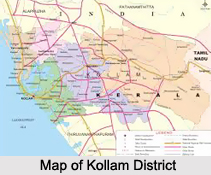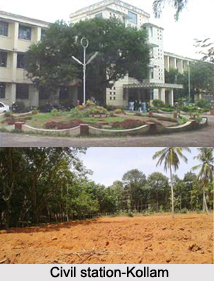 Administration of Kollam district is carried out by the District Collector. The district has been divided both geographically and on a functional basis in order to facilitate administration. Geographically it is divided into Revenue Divisions, five Taluks and 104 Villages. Functionally the District administration is carried on through the various Departments of the State Government each of which has an office of its own at the district level. Being at the centre of district administration, the District Officers of the various Departments in the district render technical advice to him in the discharge of his duties.
Administration of Kollam district is carried out by the District Collector. The district has been divided both geographically and on a functional basis in order to facilitate administration. Geographically it is divided into Revenue Divisions, five Taluks and 104 Villages. Functionally the District administration is carried on through the various Departments of the State Government each of which has an office of its own at the district level. Being at the centre of district administration, the District Officers of the various Departments in the district render technical advice to him in the discharge of his duties.
The District Collector is a key functionary of Government having large powers and responsibilities. He has a dual role to play both as the agent of the Government and also as the representative of the people in the district. He is responsible for the maintenance of law and order being the Chief Executive Officer of the district. Through the District Officials of the various Departments are under the immediate control of the representatives head of the Departments, the Collector exercises the general supervision over them in regard to their non-technical work. On matters of general policy the decision of the District Collector is final in case of any difference of opinion between him and a District Officer. The Collector inspects all important offices and works undertaken in the District.
In spite of the immense power vested in him the Collector practically restricts his inspection work to the following offices, viz., the Revenue Offices, the Police Stations, Educational Offices and Schools, Panchayat, registration Offices, Excise and Sales Tax Offices, Hospitals and Dispensaries, Agricultural Offices, Veterinary Offices and Dispensaries. In his office the District Collector, Kollam, is assisted by a staff consisting of 5 Deputy Collectors, a Sheristadar, a Tahsildar, a Senior Superintendent, 3 Confidential Assistants, 2 Head Clerks, 18 Junior Superintendent, 63 Upper Division Clerks, 26 Lower Division Clerks, 20 Typists, 5 Drivers, an Attender and 39 Peons.
 The District Collector is the head of the Land Revenue Department in the District. The hierarchy of the officials under the immediate control of the Collector for the administration of the land revenue includes Revenue Divisional Officer with headquarters at Kollam, Additional District Magistrate, Sub Collectors, Tahsildars and Special Tahsildars for five Taluks, Special Tahsildar in special offices, Deputy Tahsildars, Village officers, Head Clerks, Upper Division Clerks, Lower Division Clerks, Typists, Village Man and Peons. The powers and functions of the Revenue Divisional Officer run almost parallel lines with those of the Collector. The Tahsildar in charge of each Taluk is primarily the Revenue Official responsible for the collection of revenue, but he is also expected to be in direct contact with the people at all levels and to have first hand knowledge of the conditions of every village under his jurisdiction. The Tahsildar is assisted in each village by Village Officers and Village Assistant.
The District Collector is the head of the Land Revenue Department in the District. The hierarchy of the officials under the immediate control of the Collector for the administration of the land revenue includes Revenue Divisional Officer with headquarters at Kollam, Additional District Magistrate, Sub Collectors, Tahsildars and Special Tahsildars for five Taluks, Special Tahsildar in special offices, Deputy Tahsildars, Village officers, Head Clerks, Upper Division Clerks, Lower Division Clerks, Typists, Village Man and Peons. The powers and functions of the Revenue Divisional Officer run almost parallel lines with those of the Collector. The Tahsildar in charge of each Taluk is primarily the Revenue Official responsible for the collection of revenue, but he is also expected to be in direct contact with the people at all levels and to have first hand knowledge of the conditions of every village under his jurisdiction. The Tahsildar is assisted in each village by Village Officers and Village Assistant.
Civil station-Kollam
Veluthampi Dalava constructed the Huzur Cutcheri near Tangasseri in 1804 and during the reign of Swati Tirunal (1829) Kollam ceased to be the seat of the Huzur Cutchery. The Cutchery was thoroughly reorganised and the beginnings of the secretariat system were laid during the reign of Diwan Col. Munro. The present Civil Station was constructed in 1956 with a view to incorporate all government offices under one roof. The various offices located here include the District Information Office, the Regional Transport Office, National Informatics Centre, District Planning Office, District Supply Office, District Social Service Office etc.



















